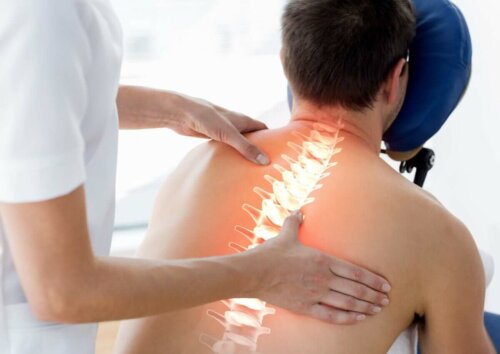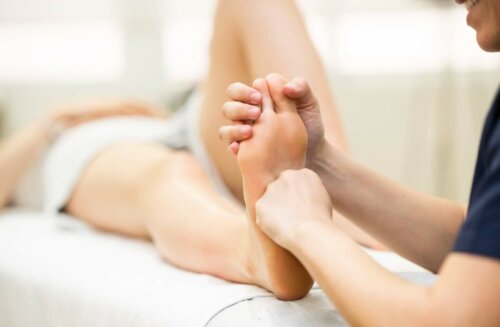How Do Neuromuscular Massages Work?

Neuromuscular massages are a great way to relax the tissues in the body. They’re effective for recovering from a training session, treating discomfort, contractures, and more.
Up next, we’re going to focus on how this type of massage works. That is, we’ll analyze how they achieve their effects and what benefits they produce in the body.
What are neuromuscular massages?
Neuromuscular massages consist of applying different degrees of pressure on the soft tissues of the body. In addition to this fluctuating pressure, specific movements are also made with the hands, which seek to generate the following benefits:
Pain reduction
It’s the key symptom that makes a person want to receive a message of this type. Although there may be some residual pain at the end of the session, the relief will be noticeable after a few hours.
Above all, it’s ideal for treating chronic pain, which lasts for several days or even weeks and months and doesn’t go away. Its effects are proven by academic literature, such as this study, carried out by professionals from the University of Cauca.
Neuromuscular massages eliminate contractures
The purpose of the massage is to relax the muscles, so one of its main benefits is the elimination of muscle tissue that’s in a pathological state. In the case of contractures, the fibers causing the discomfort will be specifically treated, returning them to their usual state. This effect is also known as normalizing muscle tone, as it will no longer be artificially contracted.
Increased mobility

As we’ve seen, this massage relaxes the muscles. Another benefit of having the muscles in their natural state is that we’ll enjoy greater mobility. This means the muscles will stretch instead of being stiff, and we’ll notice it in every movement.
Improves circulation
By eliminating pathological states, it seeks to restore normal levels of circulation. This not only helps to keep the muscle in proper condition; good circulation is also necessary to remove harmful substances.
Neuromuscular massages: how does it work?
Neuromuscular massages base their effectiveness on stimulation. The focus of this method is to stimulate fibers so that they’re put to work and recover the normal contraction-relaxation cycle.
This is also applicable to the tendons and it can even stimulate the nerves so that they remember how to perform their functions correctly; according to a degree project presented at the University of Castilla-La Mancha. To understand how they work, we’re going to analyze different pathological factors.
Trigger points
One of the symptoms that neuromuscular massages will treat with the most attention is the so-called trigger point. These are the exact fibers that are pathologically contracted and are the source of contractures and other muscle pain.
The massage therapy technique in this case consists of holding down these pathological fibers for about 30 seconds. During this time, the pressure is modulated so that the patient feels a certain degree of pain, which will disappear over time.
Afterward, the pressure is suddenly released and a large amount of blood flows to the area, eliminating harmful substances. By suddenly increasing circulation, the fibers return to their normal state.

Postural problems
When a muscle or group of muscles relaxes, we also achieve an improvement in posture. That is, we work on individual elements so that the whole body works correctly.
This is why a neck contracture can give us lumbar problems. Although it seems that it has no connection, when a muscle is pathological, the rest of the body tries to protect it. This leads us to adopt unnatural postures that can end up compensating for other muscle groups.
Fatigue
Combining rest with neuromuscular massages comes in handy to renourish the muscles. Again, we’re referring to an increase in circulation due to the pressures and relaxations in the pathological fibers.
This increase in blood flow, which we’ll notice in the form of heat, also helps the muscles to hydrate and nourish themselves. Thus, it’ll help us recover before intense sports sessions.
Great help for athletes and sedentary people
As we can see, neuromuscular massages are positive because they treat various facets of the muscles, tendons, and nerves. Stimulation can help athletes who train hard, but it’s also beneficial for sedentary people who suffer from contractures due to poor posture.
Treating these ailments helps the patient have greater mobility and quality of life. This is why it’s one of the most popular techniques in physiotherapy sessions.
Neuromuscular massages are a great way to relax the tissues in the body. They’re effective for recovering from a training session, treating discomfort, contractures, and more.
Up next, we’re going to focus on how this type of massage works. That is, we’ll analyze how they achieve their effects and what benefits they produce in the body.
What are neuromuscular massages?
Neuromuscular massages consist of applying different degrees of pressure on the soft tissues of the body. In addition to this fluctuating pressure, specific movements are also made with the hands, which seek to generate the following benefits:
Pain reduction
It’s the key symptom that makes a person want to receive a message of this type. Although there may be some residual pain at the end of the session, the relief will be noticeable after a few hours.
Above all, it’s ideal for treating chronic pain, which lasts for several days or even weeks and months and doesn’t go away. Its effects are proven by academic literature, such as this study, carried out by professionals from the University of Cauca.
Neuromuscular massages eliminate contractures
The purpose of the massage is to relax the muscles, so one of its main benefits is the elimination of muscle tissue that’s in a pathological state. In the case of contractures, the fibers causing the discomfort will be specifically treated, returning them to their usual state. This effect is also known as normalizing muscle tone, as it will no longer be artificially contracted.
Increased mobility

As we’ve seen, this massage relaxes the muscles. Another benefit of having the muscles in their natural state is that we’ll enjoy greater mobility. This means the muscles will stretch instead of being stiff, and we’ll notice it in every movement.
Improves circulation
By eliminating pathological states, it seeks to restore normal levels of circulation. This not only helps to keep the muscle in proper condition; good circulation is also necessary to remove harmful substances.
Neuromuscular massages: how does it work?
Neuromuscular massages base their effectiveness on stimulation. The focus of this method is to stimulate fibers so that they’re put to work and recover the normal contraction-relaxation cycle.
This is also applicable to the tendons and it can even stimulate the nerves so that they remember how to perform their functions correctly; according to a degree project presented at the University of Castilla-La Mancha. To understand how they work, we’re going to analyze different pathological factors.
Trigger points
One of the symptoms that neuromuscular massages will treat with the most attention is the so-called trigger point. These are the exact fibers that are pathologically contracted and are the source of contractures and other muscle pain.
The massage therapy technique in this case consists of holding down these pathological fibers for about 30 seconds. During this time, the pressure is modulated so that the patient feels a certain degree of pain, which will disappear over time.
Afterward, the pressure is suddenly released and a large amount of blood flows to the area, eliminating harmful substances. By suddenly increasing circulation, the fibers return to their normal state.

Postural problems
When a muscle or group of muscles relaxes, we also achieve an improvement in posture. That is, we work on individual elements so that the whole body works correctly.
This is why a neck contracture can give us lumbar problems. Although it seems that it has no connection, when a muscle is pathological, the rest of the body tries to protect it. This leads us to adopt unnatural postures that can end up compensating for other muscle groups.
Fatigue
Combining rest with neuromuscular massages comes in handy to renourish the muscles. Again, we’re referring to an increase in circulation due to the pressures and relaxations in the pathological fibers.
This increase in blood flow, which we’ll notice in the form of heat, also helps the muscles to hydrate and nourish themselves. Thus, it’ll help us recover before intense sports sessions.
Great help for athletes and sedentary people
As we can see, neuromuscular massages are positive because they treat various facets of the muscles, tendons, and nerves. Stimulation can help athletes who train hard, but it’s also beneficial for sedentary people who suffer from contractures due to poor posture.
Treating these ailments helps the patient have greater mobility and quality of life. This is why it’s one of the most popular techniques in physiotherapy sessions.
All cited sources were thoroughly reviewed by our team to ensure their quality, reliability, currency, and validity. The bibliography of this article was considered reliable and of academic or scientific accuracy.
- P. Vernaza. El masaje como técnica de intervención en el manejo del dolor. Revista de la Facultad de Ciencias de la Salud de la Universidad del Cauca. Vol 9, Núm 2, 2007
- V. Cardos. Eficacia de la reeducación neuromuscular en la parálisis facial. Trabajo de Fin de Grado en la UCLM, 2016.
- J. Rodríguez, J. Bustos, C. Amariles et al. El masaje terapéutico en lesiones musculares producidas por traumas de tejidos blandos. Revista Médica de Risaralda. Vol. 8, Núm. 2, 2002
This text is provided for informational purposes only and does not replace consultation with a professional. If in doubt, consult your specialist.








